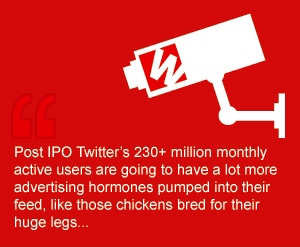Clown cars, gold mines and Happy Meals
There’s plenty of stuff in this world the Informer doesn’t understand and how companies that make no money can rake it in from a stock market floatation is one of them. The Twitter founders buzzed the bell at the New York Stock Exchange on Thursday and released 70 million shares to the frenzied masses. Despite opening at $26, the market closed at almost $45, with the company reflecting a market value of more than $31bn. The company’s valuation ahead of the IPO was closer to $17bn.
November 8, 2013

By The Informer
There’s plenty of stuff in this world the Informer doesn’t understand—and how companies that make no money can rake it in from a stock market floatation is one of them. The Twitter founders buzzed the bell at the New York Stock Exchange on Thursday and released 70 million shares to the frenzied masses. Despite opening at $26, the market closed at almost $45, with the company reflecting a market value of more than $31bn. The company’s valuation ahead of the IPO was closer to $17bn.
And this is for a company that has never made a single penny in profit and has an estimated monthly burn rate of several million dollars. Still at least the process went smoothly, unlike the debacle that was Facebook’s debut on the stock market last year. So you might expect some sour grapes from Mark Zuckerberg, who is reported to have told a friend: “It’s as if they drove a clown car into a gold mine and fell in.”
The social media darling’s concern now is how to keep users engaged while driving advertising revenues. Essentially this means Twitter’s 230+ million monthly active users are going to have a lot more advertising hormones pumped into their feed, like those chickens bred for their huge legs. According to Eden Zoller, principal analyst at Ovum, the format constraints that make Twitter such a dynamic and immediate service also limit its ability to innovate compared to a much broader platform like Facebook. Twitter must balance the introduction of new ad formats into the Twitter stream without compromising the user experience. “If it fails to get this right it will jeopardize user engagement and with it advertising spend. At the same time, investing in new service and advertising features will also push up costs, which if not carefully controlled will further impact Twitter’s ability to generate profits,” Zoller said.
It’s a catch 22 and the IPO is attracting attention from other quarters too. Earlier this week IBM made claims that Twitter is infringing at least three IBM-owned patents to do with mobile advertising and web links. The claims have not yet made it to court but IBM has an extensive patent portfolio and has invited Twitter to “negotiate” for a resolution. Big Blue has made a tidy sideline out of patent suits in the past and can clearly smell blood, or at least money, in the water.
From money in the water to money in the internet, where another concept currency has seen a surge of its own. Bitcoin crested the $300 mark late in the week, an all time high, with no apparent reason for the boost.(This is great news for the Informer’s nest egg. The Bitcoin he bought for $112 in March is now worth $312. Slow and steady wins the race.)
Perhaps it was the appearance of Silk Road 2.0, which opened its doors on Thursday, established by keen users of the now defunct predecessor. The new founder even continued the tradition of adopting the Dread Pirate Roberts moniker. #weriseagain.
That’s not a hashtag likely to be used by Canadian device vendor Blackberry, which has been forced to accept a reduced investment from Fairfax Financial Holdings after the investor was unable to raise the cash for a full takeover. Instead, Blackberry will get an investment of $1bn (down from an initially optimistic tender of $4.7bn) and in exchange will see the back of CEO Thorsten Heins.
Former CEO of enterprise mobility software provider Sybase, John S. Chen, will be installed as interim CEO while the search for a permanent replacement is carried out. It’s being suggested that Chen’s roots in software suggest that Fairfax sees the future of the company as a software firm, which many think to be a sensible move. However, the margins in the software business are thin and Blackberry will have to find ways to ramp up its revenue in order to counteract the decline in device sales.
Meanwhile incumbent operator Swisscom has just completed its search for a new chief, having appointed Urs Schaeppi as CEO. Schaeppi has been acting CEO since July 23, following the death of former CEO Carsten Schloter.
There’s been quite a lot of M&A activity happening, led by Spanish carrier Telefonica which cashed in its Czechs and Slovaks, offloading the units to Czech investment group PPF. The firm is to sell a 65.9 per cent stake in the Czech business to PPF for €2.47bn and will retain a 4.9 per cent share and remain an “industrial and commercial partner” of the operation for the next four years.
Telefónica, which built a substantial debt pile investing in Latin America, has pledged to cut debt to below €47bn by the end of 2013, partly through disposal of non-core assets. Earlier this year it announced that it had slashed debt by €10bn in the twelve months to the end of June, following disposals in Central America and Inversis and its exit from the Irish market through the sale of its assets there to Hutchison’s 3.
Also looking to dispose of non-core assets is French media firm Vivendi, which can finally see light at the end of the tunnel as the struggle for control of MarocTelecom comes to a close. The tussle has been rolling on since the start of the year but Emirates-based Etisalat this week signed a €3.9bn deal to acquire Vivendi’s 53 per cent stake in the Moroccan operator.
Over the course of the year several operators have been jostling for control of the company, including Ooredoo, France Telecom, Qatari operator Qtel and South Korea’s KTCorp. But not everyone can win and Qatari operator group Ooredoo has got its hands full elsewhere now that it has one million mobile money customers across its global footprint.
The firm has partnered with Qatar National Bank (QNB) and MoneyGram on Ooredoo Mobile Money in Qatar, which has seen strong take-up by international workers who need to send money home to their friends and family, the operator said. In Indonesia, Indosat, in which Ooredoo has a five per cent stake, has partnered with QNB Kesawan and in Tunisia, Tunisiana Ooredoo and Tunisian Mail (La Poste Tunisienne) have partnered on mobiflouss, which enables customers to top-up their airtime account, transfer money and pay bills via their mobile.
Back to the buying, however, and customer experience specialist Amdocs is to acquire network management and SON solutions provider Celcite in a deal worth $129m in cash to expand the Amdocs customer experience portfolio further into the network software domain.
The company is on a bit of a roll, only in September did it acquire network management outfit Actix for another $120m in cash to further flesh out its portfolio and offer more comprehensive equipment-agnostic optimisation solutions.
Hardly a week goes by without an acquisition by networking vendor Cisco and this week is one of those weeks. The Informer’s just read that back and he’s not sure it makes sense. But you know what he means. The company has announced its intent to fully acquire start up datacentre and cloud solutions provider InsiemeNetworks, which it already invested $135m in last year. By paying out a further $863m Cisco gets to take the firm home.
Insieme operates in the murky world of SDN and virtualisation, but has gone to great pains to distance itself from pure software based overlay virtualised networks in the datacentre, such as the Nicira technology that VMware acquired, Juniper’s Contrail, and Alcatel-Lucent’s Nuage.
Huawei was also spending big on tech, having pledged to invest a minimum of $600m in research and innovation in 5G technologies by 2018. The firm predicts that the first 5G networks will be commercially deployed from 2020 and will deliver peak data rates of over 10Gbps – 100 times faster than today’s 4G networks.
Meanwhile, Nokia Solutions and Networks (NSN) was moving in on Huawei’s turf, teaming up with China Mobile’s Research Institute (CMRI) to further their cooperation on research and standardisation of LTE and 5G technologies.
What with all this talk of 5G now it’s easy to forget poor old 3G, which seems to be exactly what UK carrier Vodafone has done. The company got a mild reprimand from UK telecoms regulator Ofcom which handed out the dunce’s hat and said that Vodafone is the nation’s only mobile operator to have failed to meet its 3G coverage obligation, falling just 1.4 per cent short of the 90 per cent coverage requirement. Ofcom’s not angry, it’s just disappointed.
The company now has an extension on its homework and has put in place a plan to bring itself into compliance with the 3G coverage obligation by the end of 2013.
EE, Three and O2 have successfully met the obligation and EE is looking to be the country’s golden boy, this week switching on what it claims is the world’s fastest LTE-Advanced (LTE-A) network, offering London’s Tech City speeds of 300Mbps. The network makes use of carrier aggregation – bringing together 20MHz of 1800MHz spectrum and 20MHz of 2.6GHz spectrum – and will bring some competition to South Korean operators which have been offering LTE-A commercially for some time now.
In a speech given in London, Swantee said that EE has seen a number of trends since launching the 4G network a little over a year ago, such as upload traffic exceeding download traffic, particularly at live sport or music events, a 20 per cent spike in traffic when tennis player Andy Murray won Wimbledon, 4G services replacing the need for public wifi services and over a third of traffic on the network attributable to video, streaming, downloads, uploads and video calls.
It was these observations which presumably prompted the carrier to also launch what it claims to be the world’s largest mobile data plan, offering a petabyte (a million gigabytes) of data, for a cool £8m. Fortunately in these days of 24 month contracts, there’s no time limit to use the allowance and a good thing to, since said allowance is the equivalent to 500 billion pages of standard printed text or 13 years of HD video streaming, according to EE. That is an awful lot of cats falling off an awful lot of sofas.
But the plan has actually been developed for professional cat filmers – business customers in the media, film, entertainment and CCTV security industries that transfer large amounts of data over 4G while on the move. We all know the LTE network is empty now but what about in the future when the great unwashed masses are crowding onto it? Anywhere you see one of those vans that used to have a satellite dish on the roof parked up, you can almost guarantee it’ll be pumping out enough traffic to crush the network. That cool £8m is essentially a licence to screw EE’s network.
And if you do the math, EE’s Super Bundle, as it’s known, actually costs about £8 per Gb, which isn’t that cheap, although the operator does say that it’s a good bit cheaper when compared to satellite uplink, which is in the range of £20 per Gb. And you might get some funny looks if you went into a high street store and tried to sign up for it. Although EE is also offering Super Bundles in 50TB, 100TB, 200TB, 500TB units too.
One organisation that might be in need of a way of shifting large amounts of data is the Internet Archive, although it’s based in San Francisco. They say that once something has been published online, you can never delete it. Just ask Beyonce. The Internet Archive is the operator of the Wayback Machine, which maintains snapshots of as many websites as it can get to at various points in history. But this week the company suffered a major fire which destroyed an estimated $600,000 of equipment.
Perhaps an arson attack by someone who really, really wanted that horrendous picture from the mid-nineties to finally go away?
On the subject of fires, it’s been a bad time for electric car champion Tesla, which is currently in the process of launching in the UK. The third Model S to catch fire in six weeks has prompted US authorities to start an investigation into the vehicles and more specifically, how well their battery packs are protected.
On the subject of authority investigations, you can’t have a week without some comment on the ongoing spy scandal. Claims have now emerged that the CIA is paying up to $10m per year for the likes of AT&T to facilitate the tapping and capture of phone records, which would be a nice little earner.
Over in the UK, pressure group Privacy International has filed formal complaints against several telcos for helping British spy agency GCHQ in its mass interception of data. The organisation referenced media reports suggesting that BT, Verizon Enterprise, Vodafone Cable, Viatel, Level 3 and Interoute all granted access to their fibre optic networks for the UK’s GCHQ surveillance program, Tempora (again, who names these things? And is that prawn or vegateable?).
The group said that if the allegations are true, the world’s telcos have undermined their customers’ internationally recognised human rights and contributed to adverse human rights impacts.
In related news, Apple has revealed details of the requests for customer data it has received from governments worldwide. While the US made far more requests than any other government – between 1,000 and 2,000 in the six months to June 30 – the UK was second on the list, having made 127 requests for data during the period. Spain Germany and Australia completed the top five.
It should be noted that the vast majority of these requests are in relation to robberies or thefts or even missing persons enquiries and not matters of national security and the company actually did something quite conscionable, which was to insert a ‘warrant canary’ into its release.
One particular paragraph of the document reads: “Apple has never received an order under Section 215 of the USA Patriot Act. We would expect to challenge such an order if served on us.”
It seems innocuous enough but if the company had been served it would be legally prevented from talking about it, so by adding this paragraph it can show that to date it hasn’t. But if that paragraph disappears in future releases then you know what’s up. Neat eh?
Now finally, and the Informer is not sure whether this is neat or scary, is news that McDonald’s is considering introducing 3D printers into its restaurants so that the plastic toys that go into Happy Meals can be printed on site. It surely won’t be long before the company is considering 3D printing the entire meal, if they don’t do that already.
You want fries with that?
Take care
The Informer
Read more about:
DiscussionYou May Also Like






.png?width=300&auto=webp&quality=80&disable=upscale)


_1.jpg?width=300&auto=webp&quality=80&disable=upscale)


.png?width=800&auto=webp&quality=80&disable=upscale)